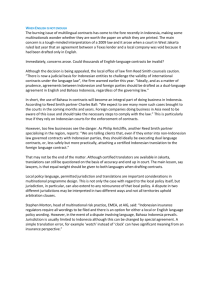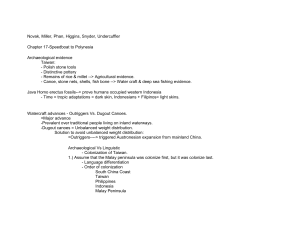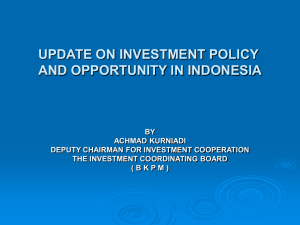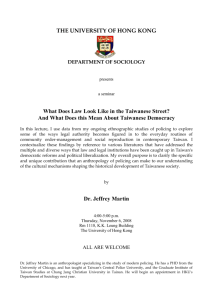1 The role of counterparts to succeed people-to
advertisement
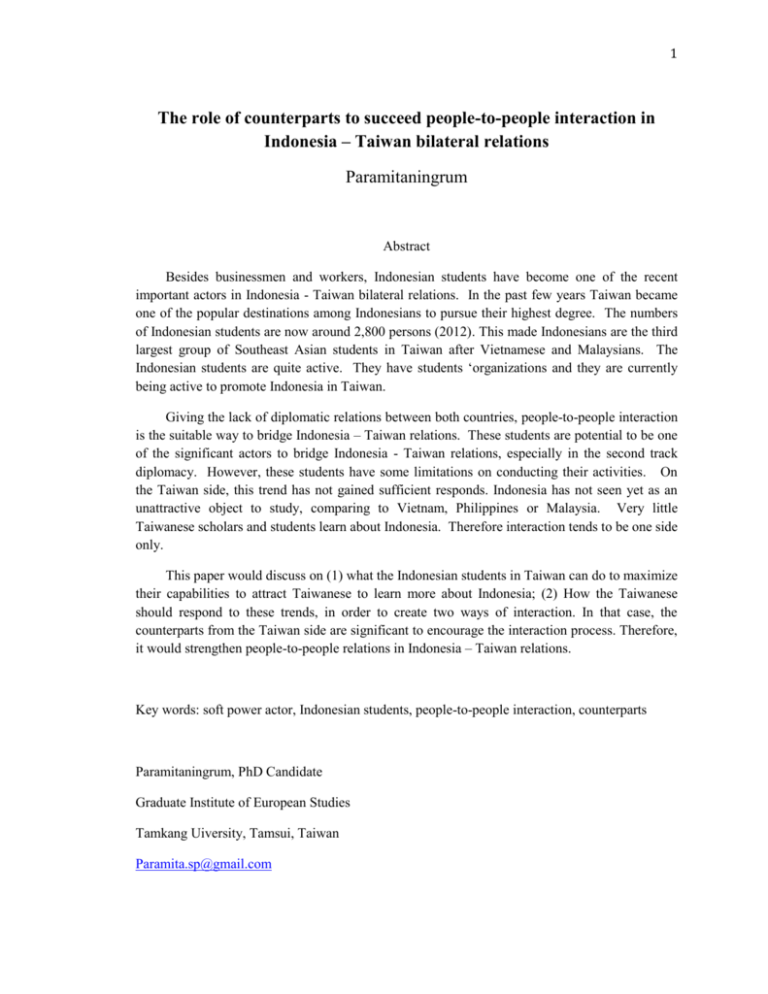
1 The role of counterparts to succeed people-to-people interaction in Indonesia – Taiwan bilateral relations Paramitaningrum Abstract Besides businessmen and workers, Indonesian students have become one of the recent important actors in Indonesia - Taiwan bilateral relations. In the past few years Taiwan became one of the popular destinations among Indonesians to pursue their highest degree. The numbers of Indonesian students are now around 2,800 persons (2012). This made Indonesians are the third largest group of Southeast Asian students in Taiwan after Vietnamese and Malaysians. The Indonesian students are quite active. They have students ‘organizations and they are currently being active to promote Indonesia in Taiwan. Giving the lack of diplomatic relations between both countries, people-to-people interaction is the suitable way to bridge Indonesia – Taiwan relations. These students are potential to be one of the significant actors to bridge Indonesia - Taiwan relations, especially in the second track diplomacy. However, these students have some limitations on conducting their activities. On the Taiwan side, this trend has not gained sufficient responds. Indonesia has not seen yet as an unattractive object to study, comparing to Vietnam, Philippines or Malaysia. Very little Taiwanese scholars and students learn about Indonesia. Therefore interaction tends to be one side only. This paper would discuss on (1) what the Indonesian students in Taiwan can do to maximize their capabilities to attract Taiwanese to learn more about Indonesia; (2) How the Taiwanese should respond to these trends, in order to create two ways of interaction. In that case, the counterparts from the Taiwan side are significant to encourage the interaction process. Therefore, it would strengthen people-to-people relations in Indonesia – Taiwan relations. Key words: soft power actor, Indonesian students, people-to-people interaction, counterparts Paramitaningrum, PhD Candidate Graduate Institute of European Studies Tamkang Uiversity, Tamsui, Taiwan Paramita.sp@gmail.com 2 I. Introduction Besides businessmen and workers, Indonesian students have become one of the recent important actors in Indonesia - Taiwan bilateral relations. In the past few years Taiwan became one of the popular destinations among Indonesians to pursue their higher degree. The numbers of Indonesian students are now around 2,800 persons (2012) and it put Indonesians in the third largest group of Southeast Asian students in Taiwan after Vietnamese and Malaysians. The Indonesian students are quite active. They have students’ organizations and they are currently being active to promote Indonesia, in Taiwan. Giving the lack of diplomatic relations between both countries, people-to-people interaction is the suitable way to bridge Indonesia – Taiwan relations. These students are potential to be one of the significant actors to bridge both countries bilateral relations. However, these students also have some limitations on conducting their activities. On the Taiwan side, this trend has not gained sufficient responds. Indonesia has not seen yet as an unattractive object to study, comparing to Vietnam, Philippines or Malaysia. The number of Taiwanese scholars and students learn about Indonesia is still very little. Therefore interaction tends to be one side only. Regarding to the obstacles facing by both sides, this paper would discuss on (1) what Indonesia and Taiwan can do to maximize their interaction; (2) How the Taiwanese should respond to these trends, in order to create two ways of interaction. In that case, the counterparts from the Taiwan side are significant to encourage the interaction process. 3 Therefore, it would strengthen people-to-people interaction in Indonesia – Taiwan relations. II. Framework of analysis Actors play a significant role in international relations. Traditionally, state is always seen as the most important international relations actor. However, in the past two decade, the role of non-state actors, including individual in international relations is increasing. According to Papp, the role of individual in international relations is often difficult to determine because of the role that same individual may have head in an organisation, agency, or government participating in international affairs.1 Papp further explained that other types of private individual contacts also pay definite but undocumentable roles in international affairs, such as student exchanges, foreign teaching & research, long term job-related migration or permanent settlement, and similar activities all yield personal level interactions between citizens of different countries.2 Individual can play diverse roles in contemporary international affairs and also play major roles in transmission of culture and values, in policy formulation and implementation, and even in economic affairs.3 Here, the Indonesian students be categorised as an ‘individual actors’ of international relations. Their activities to promote Indonesian culture refer to Papp’ explanation can be part of transmission of culture and values. 1 Daniel S. Papp. 1988 Contemporary International Relations: Framework for Understanding, 2nd Edition. London: Macmillan Publishing Company. P. 93-95 2 Ibid 3 Ibid 4 Due to the lack of diplomatic relations between Indonesia and Taiwan, the interactions between both countries are focused more on non-political issues, such as economic and social-culture. The states (both Indonesia and Taiwan) are still the main actors, but its function is limited. As a result, non-state actors also have to be involved. Indonesian students, with other non-state actors, such as Indonesian workers, Indonesian spouses and Indonesian businessmen are expected to support state actors. Since both state actors and non-state actors have limitation, another way should be done to support the efforts of state actors to promote Indonesia in Taiwan. Besides economic activities, social-cultural activities are the supporting component, which is facilitated by people-topeople interaction. People-to-people interaction applies soft power. What Indonesian students are doing to promote Indonesia can be categorised as soft power because they are trying to make other people feel attracted and would like to get to know get know more about Indonesia to meet their interests. Soft power is the ability to get what you want through attraction rather than coercion or payments. It arises from the attractiveness of a country's culture, political ideals, and policies. When our policies are seen as legitimate in the eyes of others, our soft power is enhanced." 4 The Soft power of a country depends on three resources: its culture (in places where it is attractive to others), its political values (when it lives up to them at home and abroad), and its foreign policies (when they are seen as legitimate and having moral authority).5 4 Joseph S. Nye, Jr. 2004. Soft Power: The Means to success in World Politics, New York: Public Affairs 5 Ibid 5 Soft power relies on such an attraction and agenda setting. This kind of power would call of people attention if there is multiple channel of communication; whose dominant culture and ideas are closer to the prevailing global norms (for instance multiculturalism and pluralism). The current interaction through and between states actors has not been enough, since there are some limitations (e.g. national priorities, diplomatic relations). For that reason, cooperation between state and non-state actors needs to be developed and be intensified. Therefore another official mechanism to back up the cooperation, who involves non-state actors, is needed. Currently, such interactions which involve state and non-state actors are common. In this paper, students are categorised as the non-state actors because they are considered non-sovereign entities that exercise significant economic, political, or social power and influence at a national, and in some cases international level. They are not fully autonomous from central government funding and control, but they are participating in networks which extend across the boundaries of two or more states –thus engaging in ‘transnational’ relations. They there are two main frameworks through which the world of scholars intersects with the world of policy. The first is “epistemic communities,” which is a network of professionals with recognised expertise and competence in a particular domain and an authoritative claim to policy-relevant knowledge within that domain or issue-area.6 The professionals may be from a variety of discipline and backgrounds but are bound by shared normative and causal beliefs, shared notions of validating 6 Peter M. Haas, Epistemic Communities and International Policy Coordination, International Organization, 46, (1992): 3 6 knowledge claims, and “a set of problems to which their professional competence is directed, presumably out of the conviction that human welfare will be enhanced as a consequence.” The second is “track-two dialogue” which means “unofficial policy dialogue focused on problem solving in which the participants have some form of access to official policymaking circles.” 7 Wanandi (1995) further added that track two involves the participation of government officials in a private capacity, a principle that supposedly allows for free discussion and flexibility. 8 Acharya also explained how epistemic communities and track-two forums may impact on policy:9 the firstly is through policy innovation, or generation of new policy ideas; second is the “constitutive localisation” (Acharya 2009), means whereby local actor proactively build congruence between global norms and pre-existing local ideas and practices. As part of this, they may serve as “filtering” mechanism for approaches to cooperation developed in other parts of the world so as to make them locally applicable (Acharya 1998); thirdly, epistemic communities and track-two dialogues also serve as platforms for validation and legitimization of the ideas and policies of governments; Fourthly, they can generate dissent; which while not be to the liking of policymakers, alerts them to alternative ideas and approaches out there in terms of while not be to the liking of policymakers, alerts 7 Second track dialogue is often called a second track diplomacy. See Dalia Dassa Kaye. 2007. Talking to the Enemy: Track Two Diplomacy in the Middle East and South Asia. Arlington. VA: RAND Corporation. 8 Jusuf Wanandi. 1995. The Regional Role of “Track Two” Diplomacy: ASEAN, ARF, and CSCAP, Japan Review of International Affairs, 9 : 155-168 9 Amitav Acharya. 2011. Engagement or Entrapment? Scholarship and Policymaking on Asian Regionalism. International Studies Review, 13: 12-17 7 them to alternative ideas and approaches out there in terms of which their own preferences will be benchmarked and assessed. III. A brief overview about Indonesia Indonesia is an emerging regional power. It has physical and non-physical modalities. The Republic of Indonesia is the largest archipelagic state in the world, located in Southeast Asia. It size is 1.919.440 square kilometres. Indonesia is situated in the equator between the Asian and Australian continents and between the Pacific and Indian Oceans. Indonesia consist of 18,000 islands, of 6,000 are inhabited. Indonesia has 237.6 million populations.10 It made this country the fourth largest populated country in the world, after China, India and the USA in 2010. These facts made Indonesia is considered one of the significant countries in Southeast Asia. Its population is almost half of total ASEAN population. Indonesian economy is growing. Economic annual growth rate is about 6.23 %, little bit lower than in 2011, which reached 6.5%. 11 Indonesian per capita GDP has reached $ 3495 (2011). 12 Furthermore, this country has 45 million members of the consuming class, 55 million skilled workers in Indonesian economy, and $0.5 trillion market opportunity in consumer services, agriculture and fisheries, resources, and education. It is understandable since about 42.2% of Indonesian population is in the Indonesia’s Population Ranks 4th in the world, Tempo interactive, July 14th 2011, accessed in http://www.tempo.co.id/hg/nasional/2011/07/14/brk,20110714-346661,uk.html. However, based on the estimation of CIA the World Fact book (July 2011), the population of Indonesia reached 245,613,043 million (https://www.cia.gov/library/publications/the-world-factbook/geos/id.html). 11 Indonesia's Economic Growth Slows, The Wall Street Journal, February 5, 2013, accessed in http://online.wsj.com/article/SB10001424127887324445904578285081322220700.html 12 http://data.worldbank.org/indicator/NY.GDP.PCAP.CD 10 8 productive age (25-54 years). 13 This means Indonesia is developing its capacity to strengthen its position as an emerging power. Besides, Indonesian also has other modalities such as its multiethnic identity, its political values, based on the spirit of nationalism and anti-imperialism. These inspired Indonesia’s participation in the regional and international forum. Indonesia founding fathers’ efforts to unify a country, which has multi-ethnic and multi-religious people, was noteworthy. Furthermore, Indonesia’ long process development to be a democratic country is remarkable. In the level of state-to-state interaction, the participation in ASEAN, EAS and G-20 is good indicator to show that Indonesia is an active player and Indonesia is never acts alone. In other words, Indonesia prefers to work together, instead of being a solo player. Nevertheless, not all Indonesians enjoyed their countries achievement. Non-state actors have not been more involved, since the opportunities are still limited. Based on its origin as a big and populated, multi-ethnic and multi-religious country, Indonesia shows the international community that its personal experience to develop a country is a good example. According to Sukma, the confluence of democracy & moderate Islam – described as assets of foreign policy and construed as key elements of soft power – has become an important element of Indonesia’s foreign policy and public diplomacy since 2002.14 Therefore, these two things (democracy and moderate Islam) are considered to be the value to create Indonesia’s image in the world. Although 13 https://www.cia.gov/library/publications/the-world-factbook/geos/id.html Rizal Sukma. 2011. Soft Power and Public Diplomacy: The Case of Indonesia. P. 7 in Jan Melissen and Sook Jong Lee (eds), Public Diplomacy and Soft Power in East Asia, New York - Palgrave-Macmillan. 14 9 it has not been perfect yet, Indonesia is seen as a role model for building democracy and pluralism. Bali Democracy Forum and The Interfaith Dialogue Forum help Indonesia to project its international posture. 15 Such abovementioned modalities and achievements made Indonesia have enough capacity to raise its soft powers. In addition, Indonesia has tremendous numbers of human resources to promote its soft power. As it previously mentioned, the biggest number of Indonesian population are in the productive age (25-54 years old). Some of them live in the foreign countries, as students, foreign workers, and immigrant spouses. The number of Indonesians studying abroad is between to 40.00016 to 50.000.17 Australia, U.S, the UK and Singapore were the most desirable destination for Indonesians. They have several reasons to study abroad such as gaining the better education environment, increasing the horizon, the future jobs opportunities, improving foreign language skills, and train the personal maturity and independence. Recently, Japan, Korea, Malaysia and Taiwan become the popular destination to study, because of those abovementioned reasons plus geographical one, and Taiwan’ quality of education. Those countries also provide scholarships programs for International students. 15 Both are held in 2008 and 2007. http://www.britishcouncil.org/eumd-information-background-indonesia.htm. In addition, “Vice Minister of National Education, Fasli Jalal, said now the number of Indonesian students abroad reached 40,000 people,” Seputar Indonesia, 19 January 2010, http://www.seputar-indonesia.com/edisicetak/content/view/298794/1/ 17 Antara News, I4: Berdayakan Ilmuwan Indonesia di Luar Negeri, 26 Oktober 2009. 16 10 IV. Indonesia students’ activities in Taiwan Taiwan is an interesting case study. This country does not have diplomatic relations with Indonesia. Therefore, the relation between two countries is focused more on non-political issues. Trade is the main activities, followed by cooperation in the field of economy, agricultural, health and education. Besides Indonesian businessmen and workers, Indonesian students also become one of the recent important actors in Indonesia – Taiwan bilateral relations. The number of Indonesian students now around 2800 (2012) rising from 2,520 persons (2011) and 2,275 persons (2009). They are consisted of the students of Mandarin language programs and non-language programs or degree seeking programmes (undergraduate and graduate level). The students of non-language program are mostly majoring in engineering, technology and businesses management. 18 This figure made Indonesians are the third largest group of foreigners studying in Taiwan after Vietnamese and Malaysians.19 Recently, studying in Taiwan becomes much more popular, because Taiwan government offered scholarships for International students since 2004.20 Related to Indonesia, Taiwan government has bilateral Memorandum of Understanding (MOU) with the Government of Aceh Province, to give scholarships for a number of Indonesian students from Aceh to study postgraduate in Taiwan. Several universities in Taiwan also 18 Ibid Indonesians third largest foreign student group in Taiwan, May, 5 , 2010, being accessed at http://www.antaranews.com/en/print/1273015696 20 Five government agencies (Ministry of Education (MOE), Ministry of Foreign Affairs (MOFA), Ministry of Economic Affairs (MOEA), National Science Council of the Executive Yuan (NSC) and ICDF (International Cooperation and Development Fund) ---have jointly established the Scholarship Program of Taiwan to encourage outstanding international students to undertake degree programs in Taiwan. See http://english.moe.gov.tw/ct.asp?xItem=6798&CtNode=10632&mp=1 19 11 pro-actively recruit students from several universities in Indonesia regularly. As a result, several Indonesian universities now also have double degree and sandwich programme with universities in Taiwan.21 In addition, Taiwan Education Fair is held every year in several big cities in Indonesia to attract Indonesians. Recently, Indonesian Ministry of Education also provided many kinds scholarships for Indonesian teaching staffs to pursue their higher academic degree abroad and some of them also choose Taiwan.22 Besides scholarships offers, there some other factors influence Indonesian chooses Taiwan to be their study destination. Taiwan is only a short distance from Indonesia. Furthermore, Taiwan expertise on science and technology also can meet Indonesians needs, who still deal with such limitation. Besides, Taiwan also becomes a favourite place for Indonesians who wants to improve their Mandarin language skills. Those factors as categorised as ‘push and pull’ factors by Mazzarol and Soutar (2002) 23 that increase the number of Indonesian students in Taiwan. In Taiwan, Indonesian students are quite active. There are three Indonesian students’ organizations: PERPITA, FORMMIT, and PPI-Taiwan. PERPITA (台灣印尼 僑生聯誼會) is an abbreviation from Persatuan Pelajar Indonesia di Taiwan. It was established in 1960 in National Cheng Kung University (NCKU) with 35 members. 24 This organization aimed to help Indonesian students to gain and exchange information 21 National Taiwan University of Science and technology (NTUST) and National Pingtung University of Science and Technology (NPUST) has double degree program with University of Brawijaya in Malang and Institute of Technology Sepuluh November in Surabaya. Both of them are in East Java, Indonesia. 22 This scholarship program is managed under Program Beasiswa DIKTI or the Directorate of Higher Education’ Scholarship Program 23 Tim Mazzarol & Geoffrey N. Soutar. 2002, “Push-pull” factors international student destination choice, The International Journal of Educational Management, 16 (2): 82-90 24 See http://perpita.freeinterchange.org/zh_tw/about1-02.htm 12 about studying and living in Taiwan and to facilitate Indonesian students to get together. The establishment of PERPITA also obtained support from 僑委會 or Organization of Overseas Compatriot Affairs Commission (OCAC) and 印 尼 歸 僑 協 會 (Indonesian Overseas Chinese Association). Until the year 2001, the memberships of PERPITA reached to 800 students. FORMMIT (Forum Mahasiswa Muslim Indonesia di Taiwan) or Indonesian Moslem Student Forum in Taiwan (台灣印尼學生穆斯林論壇) is established in 2006 in Taichung.25 It is aimed to maintain relationships between Indonesian Muslim students in Taiwan and to become a forum of gaining and exchanging skills and experiences among Indonesian Moslem students. The number of FORMMIT members roughly is 130 students, spread out from Northern to the Southern of Taiwan. FORMMIT has regular and special activities. Regular activities are mostly concentrated to the religious activities, such as reciting Al Qur’an together and listening to religious lecture by a cleric. But FORRMIT members also run special programme, such as teaching some skills such as Computer and Basic accounting, conducting workshop on entrepreneurships for Indonesian workers, and having a regular scientific discussion about the current issues with Indonesian and Taiwanese experts. FORMMIT also have an annual special activity, the Annual Indonesian Scholars Conference in Taiwan (AISCT). It had been held three times, and had various topics from economic, agriculture and information and 25 http://formmit.org/main-menu/about-formmit.html 13 communication technology. 26 It was attended by Indonesian scholars from Indonesia, Singapore, Japan and the Indonesian students in Taiwan. PPI Taiwan (Perhimpunan Pelajar Indonesia di Taiwan - 台灣印尼學生聯合會) or Indonesian Student Association in Taiwan is established in the 2nd of May 2010, in the commemoration of Indonesian National Education Day, in Chung Yuan Christian University, Zhongli. This organization is also aimed to gather Indonesian students in Taiwan and to play some role on developing Indonesian human resources by encouraging Indonesian students to study and to learn some skills, to develop their personal capacity. PPI Taiwan mostly cooperates with other PPI in the university levels, when these organizations conducted some activities. 27 There are some examples of these partnerships such as giving some support to several PPI in the university level, which held Indonesian Cultural Events, or academic conferences, and they work together on making a serial ‘Lentera Ide’, about the life of Indonesians (students or non-students) in Taiwan. PPI Taiwan also has some other activities, such as having picnics, helping and coordinating Indonesian students to buy flight ticket to go back to Indonesia, and the latest activity is to cooperate with Indonesian Economic and Trade Office in Taipei, to run Taiwan branch of Indonesia Open University (Universitas Terbuka – Taiwan or UTAISCT has been held in the year 2010 (in Southern Taiwan University – Tainan), 2011 (Asia University – Taichung) and 2012 (Chung Hua University – Hsinchu). The last AISCT was held in Asia University – Taichung, 27-28 April 2013. AISCT changed the name to Annual International Scholars Conference in Taiwan. 27 Several universities in Taiwan, which has around 15-300 students, such as National Taiwan University of Science and Technology (NTUST), National Cheng Chi University (NCCU), National Cheng-Kung University (NCKU), National Central University (NCU), National Dong Hwa University (NDHU), National Pingtung University of Science and Technology (NPUST), Chung Yuan Christian University (CYCU), Chinese Culture University (CCU), Asia University, established Indonesian Student Association in their school. These organisations are affiliated with PPI Taiwan. 26 14 Taiwan). This university was opened last year in Taipei. Currently, Universitas Terbuka - Taiwan has about 100 students, who are mostly Indonesian workers in Taiwan, tutored by Indonesian students, who are pursuing their graduate studies in Taiwan. Previously, Universitas Terbuka already had opened its branches in Saudi Arabia, Singapore, Malaysia, Hong Kong and South Korea. In April 2012, The First Taiwan – Indonesia Higher Education Summit was held in Taipei. This is the second high level meeting between Indonesia and Taiwan to discuss about education. The first meeting was held in Bali in 2011, while Indonesia and Taiwan signed An Agreement of Cooperation in the Field of Higher Education.28 Under this umbrella agreement, the cooperation between both countries are enhanced in several items, such as scholarships programme, academic matters (double degree, credit transfers, bridging programmes for Indonesians, who will attend PhD programme in Taiwan) and research collaboration. All those abovementioned examples show that Indonesian students are quite active. Besides studying, the Indonesian students’ activities also prove that they made positive contribution to their fellow Indonesians besides studying. These students are concerned on how to make use of their knowledge and living experience in Taiwan and how it can be applied in Indonesia. During their interaction with the Taiwanese people, they promote Indonesian multi-ethnic culture, Indonesian language, attitudes and Indonesian values. As a result, the Taiwanese are better informed that Indonesia is not only big in term of size but also its population. Indonesia has many more islands instead 28 The next Taiwan – Indonesia Higher Education Summit will be held in Bali, in the mid-2013 15 of Bali, and many ethnic groups. That means Indonesian culture is very rich, in terms of arts, food, outfit, and customs. Some Indonesian students teach Indonesian language (Bahasa Indonesia), formally or informally, to their friends or their professors. They wear Batik and other Indonesian traditional outfits in several occasions. Gradually, these students promote Indonesian language and culture to the Taiwanese society in a simple way. However, on the Taiwan side, this trend has not gained sufficient responds. Indonesia has not being seen as an attractive object to study, comparing to Vietnam, Philippines or Malaysia. There are still small numbers of research done by Taiwanese scholars, and few Taiwanese scholars understand Indonesia and its complexities. In general, there is still lack of comprehensive information about Indonesia among Taiwanese, as it explained by the Head of Taipei Economic and Trade Office (TETO), Ambassador Andrew Hsia. 29 He mentioned that only a few Taiwanese knows that Indonesia is a democratic country with good political and social stability. But most of them still tend to perceive that Indonesia as a part of Bali Island and/or as a migrant workers exporting country. This kind of perception and their partial understanding made Indonesia a less important country, in Taiwan, compared to other Southeast Asian countries. Language barrier probably becomes the main obstacles for the Indonesian students to mingle with the locals. Most of them have limited skills on Chinese language, except the ones, who focus on Chinese language. At the same time, Taiwanese people “Taiwan and Indonesia to Enhance Economic Relations,” 2 March 2013, accessed at http://www.thepresidentpost.com/?p=15615 29 16 still have strong tendency to think that all foreigners should be able to speak and read Chinese, when they come to Taiwan. Somehow, this problem may affect the students’ daily interaction with the local people and their confidence to introduce Indonesia to the Taiwanese people. Furthermore, Taiwan government is still lack of approach on how to engage these students, in the professional way, such as how to make use of these students availability in Taiwan and how to accommodate their skills, knowledge and expertise to enrich Taiwan understanding about Indonesia. Indonesian students, like other International students are still viewed only as a scholarship recipient. If Taiwan government is aware of the potency of Indonesian students, their presence can be a bridge between Taiwan and those students’ country of origin. V. Concluding Remarks Giving the lack of diplomatic relations between Indonesia and Taiwan both countries should be creative to minimize this gap. People-to-people interaction is the suitable way to bridge Indonesia – Taiwan relations. In this case, the state actors in both sides have some limitations to do the function as normal bilateral relations always work. Secondly, people-to-people interaction relies on self potential and networking. Indonesian students are potential to bridge Indonesia - Taiwan relations. Although their number is much smaller than Indonesian workers 30 , they are potential to help raising Indonesian soft power. 30 Education became a media to share and exchange their The number of Indonesian workers in Taiwan reached 187.000 (2013), mostly work as a caregivers and fishermen. It made Indonesia as the biggest Southeast Asian migrant sending country in Taiwan. 17 knowledge, skills and experience with the local people (their Taiwanese classmates, professors, or roommates/housemates) and to mingle with them. These interactions rely on the students’ self potential and it creates an opportunity to expand the networking among them. In the future, these students will be the professionals in their own fields. Besides, these interactions are less politically constrained. Through abovementioned activities, Indonesian students send a message to Taiwanese society about their positive achievements and help Taiwanese society to understand more about Indonesia and the diversity of Southeast Asia. Here it is seen that the soft power already started to work step by step. That will be much better good if there is a so-called a counterpart from the Taiwan side, to accommodate the Indonesian students’ efforts. This counterpart can be in the form of forum or association, who works on Indonesian issues, Any Taiwanese, either they are students, academician, businessmen, artists, or ordinary people can join. They can share their knowledge and experience each others. This forum or association would be the bridge between Indonesia and Taiwan, to support Indonesian – Taiwan relations. Refers to the previous explanation about epistemic community and second track diplomacy, this ‘counterpart forum or association’ can support the current activities of 2nd track dialogue and epistemic community between Indonesian and Taiwan, if any. Since epistemic community and 2nd track dialogue usually has privileges to the government access, the ‘counterpart forum or association’ can be involved in the decision making policy. 18 In sum, Indonesia and Taiwan still needs to work hard to maximise their bilateral interaction. The good strategy and collaboration between state and non-state actors in both sides still needs to be improved. People-to-people interaction should be intensified, especially to eliminate the unclear perceptions among Taiwanese to Indonesia, which might affect Indonesia – Taiwan bilateral relations, and to promote Indonesia in the better outlook.

